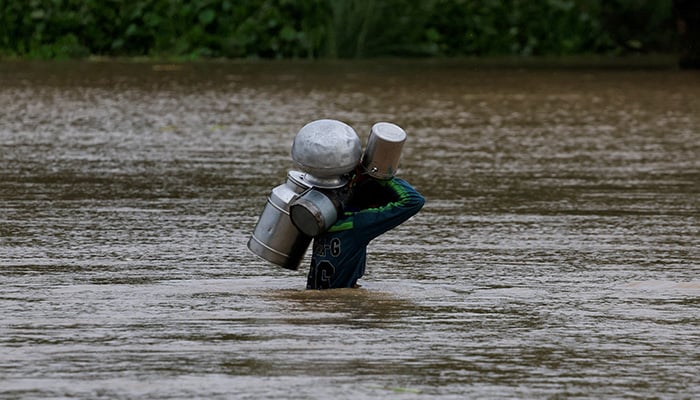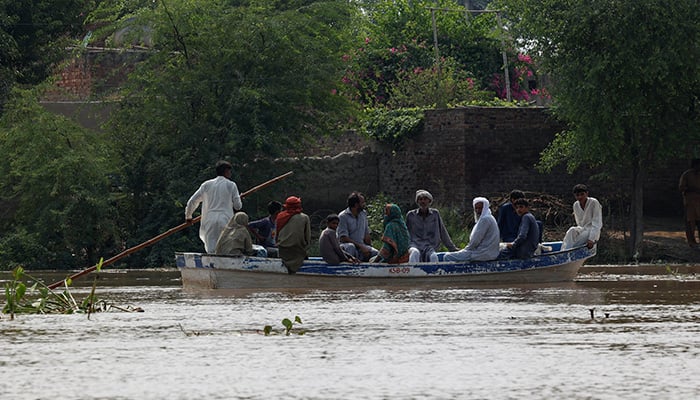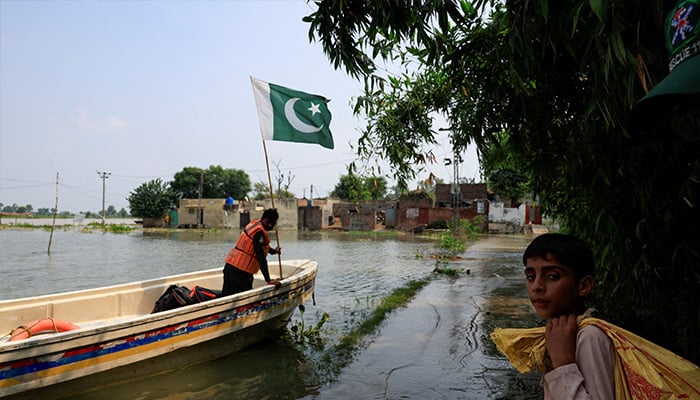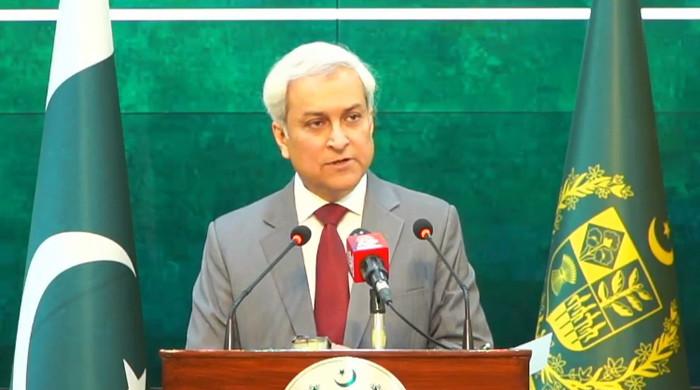Nearly 150,000 evacuated amid flood warnings as India releases water into Sutlej, Ravi
Authorities order emergency services to remain vigilant, urge citizens to avoid rivers and low-lying areas
August 26, 2025

- Punjab PDMA conducts evacuations after early flood risk warnings.
- Sutlej enters very high flood stage at multiple points after deluge.
- India informs Pakistan on water releases on humanitarian grounds.
ISLAMABAD: Nearly 150,000 people have been shifted to safer areas after the National Disaster Management Authority (NDMA) issued alerts over the rising waters in the Sutlej and Ravi rivers, following heavy rains and India’s release of water into both streams.
Since then, authorities have warned of potential flooding in adjoining districts as the rivers continue to swell.
Acting on early warnings, the Provincial Disaster Management Authority (PDMA) Punjab launched evacuation operations in vulnerable areas, relocating tens of thousands of residents from Bahawalnagar, Kasur, Okara, Pakpattan, Bahawalpur, and Vehari.
Hundreds of villages situated on the embankment of the three rivers have been evacuated.
The NDMA said about 40,000 people had already moved on their own, soon after initial advisories. Emergency response teams were deployed while all departments concerned were placed on high alert to safeguard lives and property.
Citizens have been urged to stay away from rivers, streams, and low-lying areas, avoid unnecessary travel, and strictly follow safety instructions being circulated through television, radio, mobile alerts, and the Pak NDMA Disaster Alert app.
Punjab Chief Minister Maryam Nawaz Sharif on Monday directed authorities to ensure timely evacuation of the stranded population in view of the arrival of flood torrents.
Flood situation in rivers
According to the NDMA, the flood situation in major rivers remains critical. The Sutlej has entered a very high flood stage at certain locations, while other points along the river are experiencing high to medium-level flooding.
The Ravi continues to see rising water levels, with medium flooding at some sites and low levels at others, and its tributaries including Basantar, Bein, and Deg are also in low to medium flood. The Indus River is facing medium flooding at Sukkur and low flooding at Kalabagh, Chashma, Guddu and Kotri barrages.
The Chenab has entered a low flood at Head Marala, while its tributaries are also witnessing low levels. Water flow in the Jhelum, Kabul and Nari rivers remains normal, and hill torrents in the Suleman Range and Dera Ghazi Khan division are not currently active.
Reservoirs are also filling up, with Tarbela almost full and Mangla nearing capacity, while Khanpur, Rawal and Simly dams are also recording rising water levels.

Authorities in Punjab have instructed deputy commissioners and commissioners in Lahore, Sahiwal, Multan, Bahawalpur and Dera Ghazi Khan to remain alert. Announcements are being made through mosques urging residents to move to safe locations, while relief camps and arrangements for fodder have been set up for displaced families and their livestock.
It may be noted that Punjab province, which serves as the country’s breadbasket and accounts for a large part of its food supply.
The latest warnings follow two formal contacts made by New Delhi this week to inform Islamabad about planned water discharges. India’s Madhopur Headworks has already increased inflows into the Ravi, while water released into the Sutlej has inundated parts of southern Punjab.
An Indian government source said they had not mentioned a specific dam but shared a second warning through diplomatic channels
The NDMA, in its advisory, added that heavy rainfall forecast across Indian states, including Himachal Pradesh and Uttarakhand, could further swell rivers and streams flowing towards Pakistan. Its National Emergency Operations Centre is monitoring the situation around the clock.
Diplomatic sources confirmed that India’s High Commission in Islamabad conveyed the alerts to Pakistan’s Foreign Ministry on “humanitarian grounds,” rather than through the Indus Waters Commission as required under the Indus Waters Treaty (IWT). The development came as a surprise after New Delhi announced in April that it was putting the decades-old treaty in “abeyance” following an attack on tourists in Indian Illegally Occupied Jammu and Kashmir (IIOJK) — an allegation Islamabad denies.
India’s recent decision to suspend the treaty had escalated tensions between the two nuclear-armed neighbours, leading to the most serious military clash in decades in May, before a ceasefire was brokered by the US.
Reuters reported that Delhi is also considering projects that could reduce flows into Pakistan, raising concerns in Islamabad.

Pakistan's northwest has been hammered by intense floods, accounting for half of the 799 people killed this monsoon season. The northern region of Gilgit-Baltistan has suffered accelerated glacial melting, while the southern city of Karachi was partly submerged last week.
Heavy rains in the IIOJK have already killed at least 60 people this month, while nearly 400 have died in northwestern Pakistan. In total, the floods have killed 799 people nationwide since the monsoon began in late June, according to the NDMA, which has warned of more heavy downpours until September 10.
The Foreign Office reiterated on Monday that India’s unilateral declaration to hold the treaty in abeyance “constitutes a serious violation of international law” with possible consequences for peace and stability in South Asia. It stressed that India is obligated to comply fully with the provisions of the IWT.
What is the Indus Waters Treaty?
The Indus Waters Treaty, mediated by the World Bank and signed in 1960, governs water sharing between the two countries. The agreement allocated the three eastern rivers — Sutlej, Beas, and Ravi — to India, while granting Pakistan control over the three western rivers — Indus, Jhelum and Chenab.
There is no provision in the treaty for either country to unilaterally suspend or terminate the pact, which includes dispute resolution mechanisms.
Pakistan fears India could disrupt its main water supply, endangering agriculture and hydropower, while New Delhi has warned it will not restore the treaty unless Islamabad “irrevocably abjures” support for cross-border militancy.
— With additional input from Reuters











